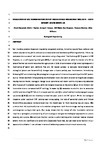Evaluation of salt marsh restoration by means of self-regulating tidal gate – Avon estuary, South Devon, UK
| dc.contributor.author | Masselink, Gerd | |
| dc.contributor.author | Furtado Frota, Francisco Gabriel | |
| dc.contributor.author | Halwyn, AC | |
| dc.contributor.author | Blake, William | |
| dc.contributor.author | Kingston, K | |
| dc.contributor.author | Newton, T | |
| dc.contributor.author | Williams, M | |
| dc.date.accessioned | 2017-08-12T14:53:24Z | |
| dc.date.available | 2017-08-12T14:53:24Z | |
| dc.date.issued | 2017-09 | |
| dc.identifier.issn | 0925-8574 | |
| dc.identifier.issn | 1872-6992 | |
| dc.identifier.other | PA | |
| dc.identifier.uri | http://hdl.handle.net/10026.1/9814 | |
| dc.description | publisher: Elsevier articletitle: Evaluation of salt marsh restoration by means of self-regulating tidal gate – Avon estuary, South Devon, UK journaltitle: Ecological Engineering articlelink: http://dx.doi.org/10.1016/j.ecoleng.2017.05.038 content_type: article copyright: Crown Copyright © 2017 Published by Elsevier B.V. All rights reserved. | |
| dc.description.abstract |
Salt marshes provide important regulating ecosystem services, including natural flood defence and carbon sequestration, which adds value to restoration and biodiversity offsetting schemes. This study evaluates the success of salt marsh restoration using a Regulated Tidal Exchange (RTE) system in SW England, i.e., a self-regulating tidal gate (SRT), in controlling the partial saline inundation of a 14-ha area of former salt marsh reclaimed for agriculture in 1760. A combination of (a) direct hydrodynamic monitoring of water and sediment flux and (b) repeat surveys to evaluate morphological and ecological (plants and foraminifera) changes over a 5-year period, was implemented immediately following SRT commissioning. Morphological changes were limited to the proximity of the SRT system due to limited sediment influx yielding sedimentation rates that were an order of magnitude below a nearby natural marsh. Ecological change to an ephemeral salt marsh community was only detected after 5 years of inundation cycles, with the delayed response attributed to (a) an initial limited tidal inundation due to conservative SRT settings, followed by (b) excessive inundation due to excessive rainfall and recurring SRT failure in an open position, and (c) a lack of sediment and propagule supply caused by (a) & (b) and the relatively narrow inlet pipe used in the SRT system. While the ecological response under optimum SRT settings was encouraging, the lack of perennial plants and limited foraminifera abundance demonstrated that the marsh was far from reaching natural status. We surmise that this is primarily due to inundation being more rapid than drainage leading to excessive submergence during a tidal cycle. Our study shows that the design of tidal inundation schemes requires a synergistic understanding of core ecological and geomorphological approaches to assess viability and success. We conclude that SRT can be a useful technique for intertidal habitat creation where there are significant site constraints (especially flood risk), but we need to be realistic in our expectations of what it can achieve in terms of delivering a perennial salt marsh community. | |
| dc.format.extent | 174-190 | |
| dc.language | en | |
| dc.language.iso | en | |
| dc.publisher | Elsevier BV | |
| dc.subject | Managed realignment | |
| dc.subject | Salt marsh restoration | |
| dc.subject | Regulated tidal exchange | |
| dc.subject | Salt marsh ecology | |
| dc.subject | Intertidal habitat creation | |
| dc.title | Evaluation of salt marsh restoration by means of self-regulating tidal gate – Avon estuary, South Devon, UK | |
| dc.type | journal-article | |
| dc.type | Journal Article | |
| plymouth.author-url | https://www.webofscience.com/api/gateway?GWVersion=2&SrcApp=PARTNER_APP&SrcAuth=LinksAMR&KeyUT=WOS:000405512600019&DestLinkType=FullRecord&DestApp=ALL_WOS&UsrCustomerID=11bb513d99f797142bcfeffcc58ea008 | |
| plymouth.volume | 106 | |
| plymouth.publication-status | Accepted | |
| plymouth.journal | Ecological Engineering | |
| dc.identifier.doi | 10.1016/j.ecoleng.2017.05.038 | |
| plymouth.organisational-group | /Plymouth | |
| plymouth.organisational-group | /Plymouth/Admin Group - REF | |
| plymouth.organisational-group | /Plymouth/Admin Group - REF/REF Admin Group - FoSE | |
| plymouth.organisational-group | /Plymouth/Faculty of Science and Engineering | |
| plymouth.organisational-group | /Plymouth/Faculty of Science and Engineering/School of Biological and Marine Sciences | |
| plymouth.organisational-group | /Plymouth/Faculty of Science and Engineering/School of Geography, Earth and Environmental Sciences | |
| plymouth.organisational-group | /Plymouth/REF 2021 Researchers by UoA | |
| plymouth.organisational-group | /Plymouth/REF 2021 Researchers by UoA/UoA06 Agriculture, Veterinary and Food Science | |
| plymouth.organisational-group | /Plymouth/REF 2021 Researchers by UoA/UoA07 Earth Systems and Environmental Sciences | |
| plymouth.organisational-group | /Plymouth/REF 2021 Researchers by UoA/UoA14 Geography and Environmental Studies | |
| plymouth.organisational-group | /Plymouth/Research Groups | |
| plymouth.organisational-group | /Plymouth/Research Groups/Marine Institute | |
| plymouth.organisational-group | /Plymouth/Users by role | |
| plymouth.organisational-group | /Plymouth/Users by role/Academics | |
| plymouth.organisational-group | /Plymouth/Users by role/Researchers in ResearchFish submission | |
| dcterms.dateAccepted | 2017-05-22 | |
| dc.rights.embargodate | 2018-6-7 | |
| dc.identifier.eissn | 1872-6992 | |
| dc.rights.embargoperiod | 12 months | |
| rioxxterms.versionofrecord | 10.1016/j.ecoleng.2017.05.038 | |
| rioxxterms.licenseref.uri | http://www.rioxx.net/licenses/under-embargo-all-rights-reserved | |
| rioxxterms.licenseref.startdate | 2017-09 | |
| rioxxterms.type | Journal Article/Review |


